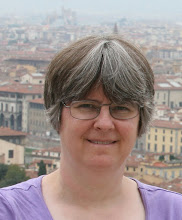Painting with Light #1
.jpg) I'm preparing a series of photos for an upcoming exhibit in February/March, and thought I'd use this as an opportunity to give you all a sneak preview. The exhibit will be called "Painting with Light." It's from a group of photographs I shot of various outdoor Christmas lights, at night, handheld, with intentional camera movement. The mystery photo from a couple of weeks ago was one of those.
I'm preparing a series of photos for an upcoming exhibit in February/March, and thought I'd use this as an opportunity to give you all a sneak preview. The exhibit will be called "Painting with Light." It's from a group of photographs I shot of various outdoor Christmas lights, at night, handheld, with intentional camera movement. The mystery photo from a couple of weeks ago was one of those.
The technique known as "painting with light" is defined as "[using] a non-stationary light source (for example, a moving flashlight in your hand) as the primary method of illuminating your subject in a creative manner." Generally you've got a still subject in a darkened room (or outdoors at night), and you illuminate it (or parts of it) progressively with a moving (and possibly interesting-colored) light source during a long exposure. We had a session on this in a photography class I took. It feels kind of like painting in the air with an enormous paintbrush (e.g., a flashlight), except you can't see what you're painting until the exposure is finished (and developed, if you're using film). Here are some interesting examples from a digital photography contest on painting with light. My photos in this series don't technically follow the textbook definition of painting with light (if there really were a textbook definition), since my subject is the light source itself. But by moving my camera, I am painting an image on the film (or in this case the digital sensor) with light.
I will post a selection of photos from my exhibit as I prepare them over the coming days. Probably little or no commentary beyond this introduction.
In this photo, the original scene was a bush with a bunch of small colored lights strung in it. Each of those colored arcs you see is created by the path of one lightbulb (my camera was moving, not the lightbulbs, but relative to my lens, it was as if the bulbs were moving). It was a relatively fast exposure compared to most in the series (1/3 sec at F/16, whereas most of them were 5 seconds). So the lines are thin and well-defined (the fact that I focused directly on the bulbs first also contributes to that), and I had to move the camera extremely fast to get any interesting pattern at all. As you'll see, though there are similarities in the series, they are all quite unique. This is one of my favorites.



No comments:
Post a Comment